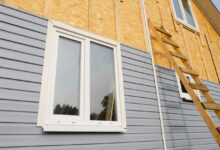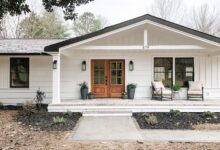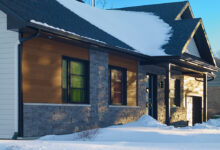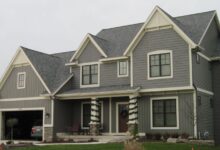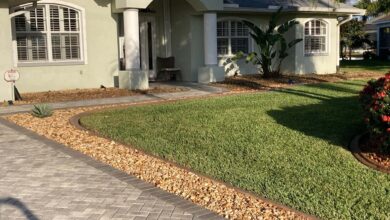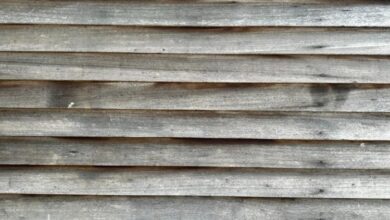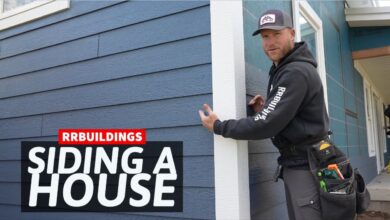Noise-Reducing Insulated Siding Panels: A Comprehensive Guide
Noise-Reducing Insulated Siding Panels represent a significant advancement in home construction and renovation, offering a compelling blend of enhanced sound insulation and improved energy efficiency. These panels, constructed from various materials like vinyl, fiber cement, or metal, incorporate advanced design features and insulation to effectively reduce noise transmission and create a more peaceful living environment. This exploration delves into the composition, installation, cost-effectiveness, environmental impact, and overall performance of these innovative panels, providing a thorough understanding of their benefits and applications.
From understanding the mechanics of sound reduction through material selection and design to exploring the various installation methods and long-term cost savings, this guide aims to equip readers with the necessary knowledge to make informed decisions about incorporating noise-reducing insulated siding panels into their projects. We will also cover crucial aspects like maintenance, durability, and environmental considerations, ensuring a comprehensive overview of this increasingly popular building material.
Product Overview
Noise-reducing insulated siding panels offer a compelling solution for homeowners seeking improved energy efficiency and sound dampening. These panels combine the protective and aesthetic qualities of traditional siding with enhanced insulation and noise-reduction capabilities, resulting in a more comfortable and quieter living environment. The manufacturing process and material composition are key factors determining their overall performance.
Noise-reducing insulated siding panels are typically constructed using a multi-layered approach. A core layer of rigid foam insulation, often polyurethane or polyisocyanurate, provides excellent thermal resistance and sound absorption. This core is then sandwiched between outer layers of various materials, offering aesthetic appeal and protection from the elements. The manufacturing process involves precisely cutting and assembling these layers under controlled conditions to ensure a high-quality, durable final product.
Material Composition and Types
The outer layers of noise-reducing insulated siding panels can be made from a variety of materials, each with its own set of advantages and disadvantages. Vinyl siding is a popular choice due to its affordability, low maintenance, and wide range of colors and styles. Fiber cement siding, on the other hand, offers superior durability and fire resistance, but is generally more expensive. Metal siding, typically aluminum or steel, provides exceptional longevity and strength, and is often chosen for its modern aesthetic. The selection of the outer layer material significantly impacts the overall cost, aesthetic, and maintenance requirements of the panel.
Thermal Performance Comparison
The thermal performance of noise-reducing insulated siding panels is largely determined by the thickness and type of insulation core. Polyurethane foam generally boasts a higher R-value (a measure of thermal resistance) than polyisocyanurate foam, meaning it provides better insulation against heat transfer. The R-value of the entire panel is also affected by the outer layer material; however, this effect is typically less significant than the contribution from the insulation core. For example, a panel with a 2-inch thick polyurethane core will generally offer superior thermal performance compared to a panel with a 1.5-inch polyisocyanurate core, regardless of the outer layer material. This translates to lower energy bills and a more comfortable indoor temperature year-round. Independent testing and manufacturer specifications should be consulted for precise R-value data for specific products.
Noise Reduction Mechanisms
Our noise-reducing insulated siding panels achieve significant sound dampening through a combination of material properties and design features. The effectiveness stems from a synergistic interaction between the panel’s core insulation and its outer layers, creating a barrier against sound transmission.
The design and materials of these panels work together to reduce noise in several key ways. The dense, multi-layered structure effectively blocks sound waves from penetrating the exterior wall. The insulation core absorbs sound energy, preventing it from traveling through the panel and into the building. The outer layers, often composed of durable materials like vinyl or fiber cement, provide an additional barrier to sound transmission.
Sound Absorption and Transmission Loss
Different panel types exhibit varying degrees of sound absorption and transmission loss. These properties are often expressed in terms of Sound Transmission Class (STC) ratings. Higher STC ratings indicate better sound-blocking capabilities. For example, a panel with an STC rating of 30 will reduce sound levels more effectively than a panel with an STC rating of 20. The specific STC rating of a panel depends on factors such as its thickness, density, and the materials used in its construction. Panels incorporating heavier materials and thicker insulation layers typically achieve higher STC ratings. This information is usually provided in the product specifications.
Insulation’s Role in Minimizing Sound Transmission
Insulation plays a crucial role in minimizing sound transmission through the panels. The porous nature of most insulation materials allows them to absorb sound energy, converting it into heat. This energy conversion process effectively reduces the intensity of sound waves passing through the panel. Different insulation types, such as fiberglass, mineral wool, or foam, have varying sound absorption properties. Higher density insulation generally provides better sound absorption, leading to a more effective noise reduction. For instance, a panel filled with high-density fiberglass insulation will offer superior sound dampening compared to one with a lower-density foam insulation. The effectiveness of the insulation is also influenced by its thickness; thicker insulation layers generally absorb more sound energy. Therefore, choosing panels with appropriate insulation thickness and density is critical for optimal noise reduction performance.
Installation Methods and Procedures
Installing noise-reducing insulated siding panels is a straightforward process, but proper technique is crucial for optimal sound insulation and longevity. This section details the necessary steps, tools, and best practices to ensure a successful installation.
The installation process generally involves preparing the wall surface, attaching the panels, and sealing any gaps to prevent sound leakage. Careful attention to detail during each step will significantly impact the overall effectiveness of the noise reduction.
Tools and Materials
Before beginning installation, gather all necessary tools and materials. This ensures a smooth and efficient process, minimizing interruptions and potential delays. A well-organized workspace is key to successful installation.
| Tool | Material |
| Hammer | Nails (appropriate size and type for your siding panels) |
| Measuring Tape | Insulated Siding Panels |
| Level | Caulk (exterior-grade, paintable) |
| Circular Saw (or appropriate cutting tool for siding material) | J-Channel (for corners and edges) |
| Safety Glasses | Flashing (for windows and doors) |
| Work Gloves | Underlayment (if required by manufacturer) |
| Utility Knife | Ladder (if necessary) |
Installation Steps
The following steps outline a typical installation process. Remember to always consult the manufacturer’s instructions for your specific siding panels, as methods may vary slightly.
- Surface Preparation: Clean the existing wall surface thoroughly, removing any loose debris, dirt, or old paint. Repair any damaged areas before proceeding. Ensure the surface is dry and level.
- Panel Measurement and Cutting: Measure and cut the panels to fit the wall sections. Use a circular saw or other appropriate cutting tool, ensuring clean, straight cuts to maintain a professional appearance.
- Panel Installation: Begin installation at a corner or edge, using J-Channel for a neat finish. Attach the panels using nails or screws, following the manufacturer’s recommended spacing and fastening techniques. Maintain consistent spacing between panels for a uniform look and to avoid stress on the material.
- Sealing Gaps: Carefully caulk all seams and gaps between panels, around windows and doors, and where the siding meets other building materials. This prevents air and sound leakage, maximizing the noise-reducing properties of the panels.
- Finishing Touches: Inspect the completed installation, ensuring all panels are securely fastened and properly sealed. Address any minor imperfections or adjustments as needed. A final walk-around will ensure a professional finish.
Best Practices for Preventing Sound Leaks
Careful attention to detail during installation is crucial for maximizing the noise-reducing capabilities of the panels. The following best practices help to minimize sound transmission.
- Proper Caulking: Use a high-quality, paintable exterior-grade caulk to seal all gaps and joints thoroughly. Apply a generous bead of caulk, ensuring complete coverage.
- Continuous Insulation: Ensure a continuous layer of insulation behind the panels to minimize sound transmission through the wall structure. Gaps in insulation can create pathways for sound.
- Proper Panel Overlap: Follow the manufacturer’s recommendations for panel overlap to create a tight, continuous seal. Improper overlap can leave gaps that compromise sound insulation.
- Seal around Penetrations: Pay special attention to sealing around windows, doors, and other wall penetrations. These areas are common points for sound leakage.
Cost Analysis and Comparison
Investing in noise-reducing insulated siding panels represents a significant upfront cost, but a thorough cost-benefit analysis reveals potential long-term savings and improved quality of life. This section compares the initial investment and ongoing expenses of these panels against traditional siding options, highlighting the financial advantages of noise reduction and energy efficiency.
The initial cost of noise-reducing insulated siding panels is generally higher than that of traditional vinyl, wood, or fiber cement siding. This price difference stems from the inclusion of advanced insulation materials and sound-dampening technologies within the panel structure. However, this increased upfront cost is often offset by substantial long-term savings in energy bills and reduced maintenance needs.
Price Comparison of Siding Options
The following table provides a general comparison of pricing for different siding materials. Note that actual costs can vary significantly based on factors such as labor costs, geographic location, and the specific product chosen. These figures represent average estimates and should be verified with local suppliers.
| Siding Material | Price per Square Foot (USD) | Installation Cost per Square Foot (USD) | Total Estimated Cost per Square Foot (USD) |
|---|---|---|---|
| Traditional Vinyl Siding | $2 – $5 | $3 – $6 | $5 – $11 |
| Traditional Wood Siding | $6 – $15 | $6 – $12 | $12 – $27 |
| Traditional Fiber Cement Siding | $8 – $18 | $7 – $15 | $15 – $33 |
| Noise-Reducing Insulated Siding Panels | $12 – $25 | $8 – $15 | $20 – $40 |
Long-Term Cost Savings
The long-term cost savings associated with noise-reducing insulated siding panels are substantial and accrue from two primary sources: reduced energy consumption and minimized noise pollution. The enhanced insulation properties of these panels significantly decrease heat transfer, leading to lower heating and cooling costs. For example, a homeowner in a climate with significant temperature fluctuations might save hundreds of dollars annually on energy bills compared to a home with traditional siding. Furthermore, reduced noise pollution translates to improved comfort and potentially higher property values. A quieter home environment can contribute to better sleep, reduced stress, and improved overall well-being, which are difficult to quantify financially but represent significant intangible benefits.
Brand and Pricing Examples
It’s crucial to remember that pricing varies considerably between manufacturers and distributors. The following table provides illustrative examples, not exhaustive pricing data. Actual prices should be confirmed directly with the relevant supplier.
| Brand | Price/sqft (USD) – Estimated Range |
|---|---|
| Brand A (Example) | $15 – $22 |
| Brand B (Example) | $18 – $25 |
| Brand C (Example) | $20 – $30 |
Environmental Impact
The environmental footprint of noise-reducing insulated siding panels is a crucial factor to consider, encompassing both the manufacturing process and the eventual disposal. Understanding the lifecycle impacts of these panels, from raw material extraction to end-of-life management, is vital for responsible building practices and minimizing the overall environmental burden.
The manufacturing process of these panels involves several steps, each with potential environmental consequences. Raw material extraction, such as harvesting wood for fiber cement panels or mining for metal components, can lead to habitat destruction and soil erosion. Energy consumption during manufacturing, including processes like mixing, molding, and curing, contributes to greenhouse gas emissions. The use of chemicals and binders in the manufacturing process also presents potential risks for water and air pollution. Finally, transportation of the finished panels to construction sites adds to carbon emissions.
Manufacturing and Disposal Impacts
Manufacturing noise-reducing siding panels, regardless of the specific material, inevitably involves energy consumption and resource depletion. For example, the production of vinyl siding requires significant amounts of fossil fuels, contributing to greenhouse gas emissions. Fiber cement panels, while often considered more sustainable due to their use of recycled materials, still require energy-intensive manufacturing processes. Metal panels also have a high embodied energy associated with their production and transportation. Disposal practices vary depending on local regulations and the panel material. Landfilling is a common method, but recycling options exist for some materials, such as metal and some types of plastic. However, recycling rates are often low, and improper disposal can lead to environmental contamination.
Sustainability of Different Panel Materials
The sustainability of different noise-reducing siding panel materials varies significantly. Fiber cement panels, which often incorporate recycled materials like fly ash and slag, generally have a lower environmental impact than vinyl siding due to their higher recyclability and lower reliance on fossil fuels. However, the manufacturing process still requires significant energy and may involve the release of certain chemicals. Wood siding, sourced from sustainably managed forests, can be a relatively sustainable option, provided it is treated to resist rot and insects without using harmful chemicals. Metal siding, while durable and recyclable, has a high embodied energy associated with its production and requires significant energy for initial manufacturing. Recycled content and the availability of responsible recycling programs significantly influence the overall sustainability of any material. For example, a vinyl siding panel made with a high percentage of recycled content would have a smaller environmental footprint than one made entirely from virgin materials.
Potential Environmental Benefits of Noise-Reducing Siding
While manufacturing and disposal present challenges, the use of noise-reducing siding can offer environmental benefits indirectly. Reduced noise pollution from traffic and other sources can contribute to improved human health and well-being, reducing stress and related health issues. This indirect benefit translates into a reduction in healthcare costs and the associated environmental impact of healthcare resource production and consumption. Furthermore, by improving the energy efficiency of buildings (reducing the need for extra soundproofing measures), noise-reducing siding can contribute to decreased energy consumption and greenhouse gas emissions. For example, a building with effective noise insulation may require less energy for heating and cooling, thus lowering its carbon footprint.
Maintenance and Durability
Proper maintenance significantly extends the lifespan and performance of noise-reducing insulated siding panels. Regular cleaning and prompt attention to any damage are crucial for preserving their aesthetic appeal and insulating properties. Ignoring maintenance can lead to premature deterioration, compromising both the building’s energy efficiency and its curb appeal.
Regular maintenance ensures the panels remain effective at noise reduction and weather protection, thereby maximizing their return on investment. The durability of these panels varies depending on the material used (e.g., vinyl, fiber cement, metal) and the specific environmental conditions.
Panel Lifespan and Durability
The expected lifespan of noise-reducing insulated siding panels depends heavily on the material composition and the environmental exposure. Vinyl siding, known for its affordability and low maintenance, typically lasts 20-30 years with proper care. Fiber cement siding, offering superior durability and fire resistance, can last 50 years or more, while metal siding, though potentially more susceptible to dents and scratches, can also achieve a similarly long lifespan if properly maintained. Harsh weather conditions, such as prolonged exposure to intense sunlight, extreme temperature fluctuations, and frequent freeze-thaw cycles, can accelerate the deterioration of any siding material, regardless of its initial durability. For example, in coastal areas with high salinity, metal siding may require more frequent maintenance to prevent corrosion. In regions with heavy snowfall, the weight of accumulated snow could potentially damage poorly installed panels.
Cleaning Procedures
Cleaning noise-reducing insulated siding panels typically involves a simple process. A gentle pressure washing with a low-pressure nozzle is usually sufficient to remove dirt, grime, and loose debris. Avoid using high-pressure settings, as this could damage the panel surface or dislodge caulking. For stubborn stains, a mild detergent solution can be used, followed by thorough rinsing with clean water. Abrasive cleaners or harsh chemicals should be avoided, as these can scratch or discolor the panels. Regular cleaning, ideally once or twice a year, will help prevent the build-up of dirt and grime that can compromise the panel’s appearance and performance.
Repairing Damaged Panels
Minor scratches or dents on vinyl or metal siding panels can often be repaired with touch-up paint or specialized repair kits. More significant damage, such as cracks or holes, may require replacing the affected panel. Fiber cement panels, due to their more robust nature, are less susceptible to minor damage but still require professional repair or replacement for significant damage. When repairing or replacing panels, it’s crucial to ensure proper sealing to maintain the panel’s weatherproofing and noise-reduction capabilities. Failure to properly seal repaired or replaced panels can lead to water infiltration, compromising the insulation and potentially causing structural damage.
Applications and Use Cases
Noise-reducing insulated siding panels offer a versatile solution for mitigating noise pollution in a variety of settings, significantly enhancing the comfort and value of residential and commercial properties. Their effectiveness stems from their ability to absorb and block sound waves, creating a quieter and more peaceful environment.
The benefits of these panels are particularly pronounced in noise-sensitive areas, offering a practical and aesthetically pleasing method for noise control. Their application extends beyond simply reducing noise levels; they also contribute to improved energy efficiency and enhanced building aesthetics.
Residential Applications
These panels are ideally suited for homes located near busy roads, airports, or industrial areas. Installing them can dramatically reduce traffic noise, airplane engine roar, or industrial machinery sounds, transforming a previously noisy home into a peaceful sanctuary. For example, a home situated near a highway could see a significant reduction in interior noise levels by utilizing these panels, improving the quality of life for its residents. This is especially beneficial for bedrooms and living areas where quiet is most valued. Consider a two-story home with these panels installed on the exterior walls facing the highway; the upper floor, typically more susceptible to noise, would experience a considerable decrease in noise penetration.
Commercial Applications
In commercial settings, noise-reducing insulated siding panels find applications in a wide range of buildings. Hospitals, schools, and offices benefit greatly from reduced noise levels, leading to improved concentration, patient recovery, and overall productivity. For instance, a school located near a busy street could utilize these panels to create a calmer learning environment, minimizing distractions from outside noise and improving student focus. Similarly, a hospital could use them to reduce noise from ambulances and traffic, contributing to a more peaceful atmosphere for patients and staff. The panels could be strategically installed on exterior walls facing noisy streets or areas with heavy pedestrian traffic.
Building Designs Incorporating Noise-Reducing Insulated Siding Panels
Effective building design incorporates these panels strategically to maximize noise reduction. This often involves focusing on the areas most exposed to noise sources. For example, in a multi-family residential building near an airport, the panels could be installed on the side of the building facing the runways, acting as a significant barrier to aircraft noise. The building’s orientation relative to noise sources should be carefully considered during the design phase, allowing for optimal placement of the panels. Another example would be an office complex situated close to a major highway. The panels could be integrated into the façade design, providing both noise reduction and a visually appealing exterior. The selection of panel color and texture could also be used to complement the overall aesthetic of the building, seamlessly integrating noise control measures into the design.
Performance Testing and Standards
Ensuring the effectiveness of noise-reducing insulated siding panels requires rigorous testing and adherence to established industry standards. These tests verify the panels’ ability to attenuate sound and provide quantifiable data for consumers and professionals. This section details the testing methodologies and relevant standards used to assess the performance of these panels.
Testing the noise reduction capabilities of insulated siding panels involves measuring the sound transmission loss (STL) across a range of frequencies. This is typically done in a reverberation chamber or a transmission loss suite, which are specifically designed acoustic laboratories. The test involves exposing one side of the panel to a controlled sound source, measuring the sound pressure level on both sides, and calculating the difference. This difference represents the sound reduction provided by the panel. Factors such as panel thickness, material composition, and installation method significantly impact the results.
Sound Transmission Class (STC) Ratings
The Sound Transmission Class (STC) rating is a widely accepted metric for quantifying the sound insulation performance of building materials, including insulated siding panels. The STC rating is a single-number rating derived from a weighted average of sound transmission loss measurements across a range of frequencies (typically 125 Hz to 4000 Hz). A higher STC rating indicates better sound insulation. For example, a panel with an STC rating of 30 will reduce the sound level by approximately 30 decibels. Different panel types, varying in material composition and thickness, will exhibit different STC ratings. A panel made of high-density materials and with a thicker core will typically have a higher STC rating than a thinner panel with a lower-density core. Many manufacturers provide STC ratings for their products based on independent testing conducted in accredited laboratories.
Impact Insulation Class (IIC) Ratings
While STC ratings focus on airborne sound, Impact Insulation Class (IIC) ratings assess a panel’s ability to reduce impact noise, such as footsteps or dropped objects. IIC ratings are determined through standardized impact testing, where a standardized impact source is used to generate sound on one side of the panel, and the resulting sound level is measured on the other side. This rating is particularly relevant for multi-family dwellings or buildings where impact noise is a significant concern. Panels with higher IIC ratings offer better protection against impact noise. For instance, a panel with an IIC rating of 50 offers significantly better impact noise reduction than one with an IIC rating of 30. The choice between panels with higher STC or IIC ratings will depend on the specific noise reduction needs of the application.
ASTM International Standards
Several ASTM International standards provide guidelines and procedures for testing the sound insulation performance of building materials. These standards specify the test methods, equipment, and reporting requirements to ensure consistent and comparable results. Compliance with these standards is essential for manufacturers to claim accurate sound insulation performance ratings for their products. For example, ASTM E90-17a details the standardized procedure for measuring sound transmission loss in building materials. Adherence to these standards allows for reliable comparisons between different panel types and brands.
Comparison of Panel Performance Ratings
The table below presents a hypothetical comparison of STC and IIC ratings for three different types of noise-reducing insulated siding panels. These values are illustrative and should not be taken as representative of actual products available in the market. Always refer to the manufacturer’s specifications for accurate performance data.
| Panel Type | STC Rating | IIC Rating |
|---|---|---|
| Panel A (Standard) | 30 | 35 |
| Panel B (Enhanced) | 35 | 40 |
| Panel C (Premium) | 40 | 45 |
Advantages and Disadvantages
Choosing noise-reducing insulated siding panels involves weighing several factors. A comprehensive understanding of both the benefits and drawbacks is crucial for making an informed decision. This section outlines the key advantages and disadvantages to help you assess the suitability of these panels for your specific needs.
Advantages of Noise-Reducing Insulated Siding Panels
The benefits of installing noise-reducing insulated siding panels extend beyond simple aesthetics. These panels offer a range of advantages that can significantly improve the comfort and value of your property.
- Superior Noise Reduction: The primary advantage is the noticeable reduction in exterior noise penetrating your home. This translates to a quieter, more peaceful living environment, especially beneficial in noisy urban areas or near busy roads. The effectiveness varies depending on the panel’s construction and the frequency of the noise, but significant reductions are achievable.
- Improved Energy Efficiency: The insulation within the panels helps regulate indoor temperatures, reducing the strain on your heating and cooling systems. This leads to lower energy bills and a smaller carbon footprint. The extent of energy savings depends on factors like climate, panel R-value, and home design.
- Enhanced Home Aesthetics: Modern noise-reducing siding panels come in a variety of colors, textures, and styles, allowing for aesthetic customization to match your home’s design. This can increase your home’s curb appeal and property value.
- Increased Durability and Longevity: Many noise-reducing siding panels are made from durable materials resistant to damage from weather, insects, and rot. This results in a longer lifespan compared to traditional siding, reducing the need for frequent replacements and maintenance.
- Low Maintenance: These panels typically require minimal maintenance, often needing only occasional cleaning. Their durability reduces the need for frequent repairs or replacements, saving time and money in the long run.
Disadvantages of Noise-Reducing Insulated Siding Panels
While offering numerous benefits, noise-reducing insulated siding panels also present some drawbacks that should be considered.
- Higher Initial Cost: The upfront cost of purchasing and installing noise-reducing insulated siding panels is generally higher than traditional siding options. This increased expense needs to be weighed against the long-term benefits of energy savings and reduced maintenance.
- Potential Installation Challenges: The installation process can be more complex than traditional siding, potentially requiring specialized tools and expertise. This may increase labor costs and could lead to delays in project completion if not handled properly.
- Limited Availability: Compared to standard siding options, noise-reducing insulated panels might have limited availability in certain regions or from specific suppliers. This could affect the choice of colors, styles, and lead times.
- Weight Considerations: These panels are often heavier than traditional siding, which may require structural reinforcement in some cases, adding to the overall installation cost and complexity. This is particularly important for older homes with less robust framing.
- Potential for Moisture Issues (if improperly installed): If not installed correctly, these panels can trap moisture, leading to potential problems like mold growth or damage to the underlying structure. Proper installation by experienced professionals is crucial to avoid such issues.
Outcome Summary
Ultimately, Noise-Reducing Insulated Siding Panels offer a compelling solution for homeowners and builders seeking to enhance both the acoustic comfort and energy efficiency of their structures. By carefully considering the various panel types, installation techniques, and long-term implications, individuals can effectively leverage the benefits of these innovative materials to create quieter, more comfortable, and environmentally responsible living spaces. The comprehensive information presented here serves as a valuable resource for anyone planning to incorporate noise-reducing insulated siding panels into their next project, enabling them to make well-informed choices that meet their specific needs and priorities.

